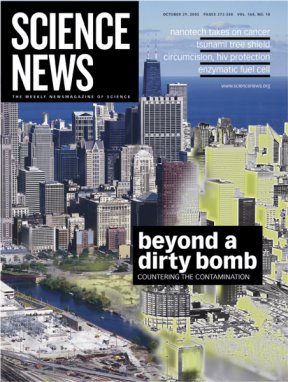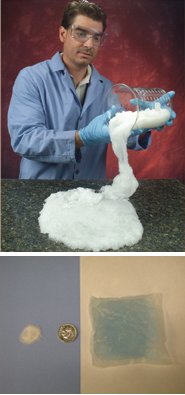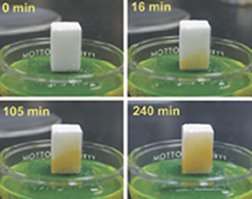It’s a lot easier to make a mess than to clean one up. This fact of life has lately become fraught with dire possibilities. Suppose the mess is radioactive? Suppose it was created by terrorists wielding a dirty bomb, an explosive laced with a radioactive substance such as uranium or cesium? What then? Reach for a bottle of Radiation-Be-Gone?




Unfortunately, such a cleaning products doesn’t exist. In the past few years, however, several U.S. government agencies have quietly focused a small research effort on developing new technologies for countering the radioactive fallout from what’s officially known as a radiological dispersal device, or RDD. Although the bomb’s conventional explosive would damage the immediate area, radioactive material would contaminate more broadly. As people fled, the radiation-tainted area could become a ghost town.
“If no one wants to go back to work in downtown Manhattan, then we’re in trouble,” says James L. Conca, director of the Carlsbad Environmental Monitoring and Research Center at New Mexico State University.
Decontamination techniques currently available, such as sandblasting and demolition, are unthinkable for many prime targets, such as downtown Manhattan or the National Mall, says Todd S. Brethauer of the Arlington, Va.–based Technical Support Working Group (TSWG). This counterterrorism-research branch of the U.S. government is funding some of the anti–dirty bomb work.
The time required for traditional methods of decontamination and their costs would be staggering. What’s more, it might be impossible to restore historic structures or revered monuments to preattack conditions.
That’s where some sophisticated chemical engineering may come to the rescue. “We’re in better shape than we’ve ever been,” says nuclear engineer Michael D. Kaminski of the Argonne National Laboratory near Chicago.
An assortment of prototype radiation-binding and -ridding gels, foams, films, and emulsions is now emerging from government, university, and industrial labs. The purpose of those materials is to restore a contaminated zone with unprecedented speed, economy, and gentleness. In fact, the inspiration for one of the new approaches came from baby diapers.
Researchers hesitate to share precise data about how well their substances work, citing their obligation to protect government or commercial secrets. “We don’t want to expose a vulnerability,” explains biologist Thomas P. McCreery of the Defense Advanced Research Projects Agency (DARPA) in Arlington, Va.
The scientists nevertheless claim that fast, complete recovery from a dirty-bomb attack increasingly looks feasible. “If we’re effective” after an attack, McCreery says, “people can just go back in there as if it never happened.”
Cover up
In a typical dirty-bomb scenario, a car bomb explodes on Wall Street in New York City, on Pennsylvania Avenue in Washington, D.C., or in some other high-profile neighborhood. The bomb contains a coffee can–size dose of cesium chloride powder. The blast kills scores of people, injures many more, and spews highly radioactive particles across some 10 city blocks.
Response teams would need to quickly clean up a huge outdoor-surface area—including buildings, plazas, streets, and cars. “The surface area in 10 city blocks in downtown Manhattan is a billion square feet,” Conca estimates. Factoring in human psychology, responders would probably have to achieve radiation levels close to the pre-attack levels.
Ironically, firefighters and other emergency personnel would probably first respond to a dirty-bomb attack by gluing the radioactive material to the contaminated surfaces. During a simulated dirty-bomb attack staged in Seattle in the spring of 2003, “one of the lessons learned was that [responders] had nothing to stop the spread of radioactive dust,” Brethauer says.
“The first step has to be to prevent further migration” of the bomb’s fallout, agrees chemical engineer Robert C. Moore of Sandia National Laboratories in Albuquerque. Immobilizing radioactive material may also enable rescue workers to do their job without becoming contaminated.
To meet those needs, researchers have been devising sticky coatings that can be sprayed from trucks and robotic sprayers or applied as paint is. The coatings have to adhere even in foul weather, maintain their integrity as vehicles roll across them, be environmentally benign, and, ultimately, be easy to remove.
Fixatives developed in the past were designed for use only on a small scale and in controlled environments, such as inside the containment building for a nuclear-power reactor, notes physicist Christina A. Lomasney, who heads the Seattle-based company Isotron Advanced Polymer Composites.
At the request of TSWG, Isotron has just developed a polymer coating that might be valuable after a dirty-bomb attack. Tests earlier this year confirmed that firefighters using standard equipment could add the material to water rushing through their hoses, just as they now add foaming agents to more effectively smother fires.
The sprayed-on polymer would dry within a few hours into a film that turns blue as it cures for easy recognition and that is tough enough to withstand truck traffic. The film remains tacky even when dry, so it continues to trap contaminants, Brethauer says.
So far, TSWG has spent a modest $350,000 on developing the coating. In a modified form, it can fix in place nonradioactive dirt, dust, and sand, for instance, during helicopter landings and takeoffs. “We’re trying to get some of the materials out to [U.S. military forces in] Iraq and see if they can help,” Lomasney says.
Taking a different tack, researchers in a year-old program sponsored by the U.S. Army Corps of Engineers have been investigating fixatives made from water-based emulsions containing asphalt or wood resins. Emulsions of similar materials are already widely used for repairing cracks in asphalt pavements and roofs.
Tests on coatings less than a millimeter thick were reported in the May 15 Environmental Science & Technology. These and other recent laboratory experiments examining the films’ toughness, impermeability to water, and chemical and physical changes in response to radiation have produced encouraging results, says study coauthor Victor F. Medina, an environmental engineer at the U.S. Army Engineer Research and Development Center in Vicksburg, Miss.
Medina estimates that the emulsions will cost as little as a hundredth the price of competing fixatives. “There’s almost no question that [their low cost] is going to be a huge advantage,” he says.
Changing times
After the immediate stabilization response to a dirty bomb, the cleanup must begin in earnest. Removing the fixative coatings—many of which are designed to peel off in large, easily disposable pieces—will clean away radioactive particles that had adhered. Yet the physical properties of many building materials—and of the radioactive isotopes, or radionuclides, that would land on them—complicate the task of thoroughly removing the contamination.
Cesium-137, strontium-90, cobalt-60, and other potential bomb ingredients are reactive metals. “They don’t just sit on the surface—they bond to it,” McCreery explains.
If the conditions are damp or wet, a water-soluble compound, such as cesium chloride, can seep several centimeters into concrete, brick, marble, and other porous building materials. Within hours to days after the attack, the radionuclide could be inside walls, where it would be much harder to clean up.
Cesium is “our lead candidate as a threat,” McCreery says. It emits gamma rays—the most penetrating radiation—and is available in devices with a range of uses, including medical treatments and food sterilization.
Argonne’s Kaminski got a bright idea about cleaning up messes 3 years ago, when his son Mikey was only a few months old. “I knew how well diapers worked for my son. I was wondering if there was a way I could make something like that that would draw the radioactivity out,” Kaminski recalls.
Disposable diapers contain a crystalline powder in which each grain contains strandlike polymer molecules chemically bound into a loose-knit mesh. When a water-based liquid, such as urine, enters the mesh, it expands and forms a thick goop. Such absorbents can soak up hundreds of times their weight in liquid.
But recovering radionuclides requires a lot more than just soaking up water. In one version of a cleanup strategy developed by Kaminski and his colleagues, crews would first hose surfaces with compounds, called extractants, designed to detach radioactive atoms that had bound to iron oxides, clays, or other ingredients within porous building materials.
Next, the crews would slather on a gel composed primarily of polyacrylates—a family of polymers also used in disposable diapers. The gel contains nanoscale particles designed to sop up the radioactive atoms released by the extractants. The nanoparticles “actually grab on to the atoms and surround them completely. They’re very aggressive,” Kaminski says.
Because the dissolved atoms entering the damp gel become sequestered in the nanoparticles, the radionuclide concentration in the gel’s water component remains minimal, and radioactive atoms continue to diffuse from the pores into the gel. To sop up the last of the radionuclides, the scientists trigger an expansion of the gel that draws water from the pores.
On some concrete surfaces, the gel absorbs more than 98 percent of radioactive atoms in about a half hour, Kaminski reports. Other surfaces require several treatments. After each treatment, he adds, a cleanup crew in protective suits would wet vacuum the tainted gel and remove it for disposal.
TSWG has spent close to $1 million so far on the Argonne gel. By the end of this year, Kaminski says, his team expects to turn over its formulas to a company that will commercialize the material.
In a program under DARPA and the Department of Homeland Security (DHS), teams at Sandia labs and at Los Alamos (N.M.) National Laboratory are also developing cleanup gels.
A tailored response
Decontamination success may hinge on the appropriateness of a cleaning agent to the particular dirt spewed by a bomb, Kaminski says. At Los Alamos, scientists are developing new forms of chemical additives, called chelators, that bind to radioactive contaminants more strongly and selectively than do those already in use. “We want chelators that are specific for our [radioactive] metals of interest” but that don’t bind to others, such as calcium, which is a major ingredient of concrete and marble, says Mark E. Smith, a polymer scientist at the lab.
Using one of the conventional, nonspecific chelators to respond to a dirty-bomb attack in an urban setting would be like throwing away the expensive compound, Smith says.
To create new chelators, the Los Alamos team has been investigating peptides, or short chains of amino acids, that can bind with high specificity to particular metals. Compared with conventional chelators, peptides are more effective in the chemical environment of damp concrete or rock, and they’re inexpensive, says Los Alamos chemist Edel M. Minogue.
To choose among tens of thousands of peptide candidates, which differ in their sequences of amino acid building blocks, Minogue and her colleagues have developed a high-throughput screening technique. They start with an array of thousands of styrene beads, each hosting just one of the candidates. Then, the researchers immerse the array in a solution rich in ordinary metals—such as iron, aluminum, and calcium—but also cobalt. Under X-ray illumination, any bead with a peptide that strongly binds one or more of the dissolved metals emits secondary X rays that indicate which metals the bead had grabbed. Its location in the array identifies the successful peptide. Minogue and her colleagues described the method in April at an optical-engineering conference in Dublin, Ireland.
After using the technique, says Minogue, “we had a winner,” and the team put it in a gel.
Other teams in the DARPA/DHS program at Isotron and at the Idaho National Laboratory in Idaho Falls have also created novel decontamination agents.
Researchers’ opinions differ over the potential roles for high-tech decontamination agents. Conca says that stockpiling the materials in sufficient quantities will be neither practical nor affordable, so he’s not counting on them to play the leading role in the response to a dirty bomb.
“The only way to clean up is to just deluge the place with water” and then let the runoff enter a nearby body of water, where the radiation will become diluted, he says.
However, Conca sees a role for the new cleaners on surfaces that don’t respond to the deluge method. He advocates storing substantial quantities of the materials, say, in a couple of railroad tanker cars, near every major city or other potential dirty-bomb target.
Watchful foes
Countermeasures to the dirty-bomb threat naturally go beyond finding better ways to clean up after the fact. For instance, some researchers are investigating ways to reduce the terrorism value of some radiation sources, such as the cesium powder in medical devices. Meanwhile, regulators are tightening controls on radioactive sources and creating more-detailed databases to keep tabs on the materials.
Ultimately, however, there may be no measure more crucial to preventing dirty-bomb attacks than cleaning up quickly after the very first one. Should an attack take place, says Conca, its perpetrators will probably be monitoring the speed and efficacy of the cleanup to decide the value of launching another attack.
“The number of dirty bombs we face,” he predicts, “will be determined by how we deal with the first.”





